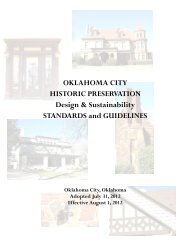OKC Plan, 2000-2020 - City of Oklahoma City
OKC Plan, 2000-2020 - City of Oklahoma City
OKC Plan, 2000-2020 - City of Oklahoma City
You also want an ePaper? Increase the reach of your titles
YUMPU automatically turns print PDFs into web optimized ePapers that Google loves.
In addition, the Solid Waste Management Division (<strong>of</strong> the Water and Wastewater Department) and<br />
the Public Works Department are responsible for various environmental services including<br />
hazardous waste disposal days, street sweeping, and clean-up <strong>of</strong> trash illegally dumped along rights<strong>of</strong>-way.<br />
Private solid waste disposal facilities in <strong>Oklahoma</strong> <strong>City</strong> include:<br />
BFI <strong>Oklahoma</strong> Landfill<br />
East Oak Landfill<br />
Newcastle Landfill<br />
OLS Inc. Midwest Landfill<br />
Southeast Landfill Authority<br />
Directions<br />
7600 SW 15th Street<br />
3000 Mosley Road<br />
1741 N. Portland Ave in Newcastle<br />
9400 SE 49th Street<br />
7001 S. Bryant Avenue (I-240 & S. Bryant)<br />
A safe and healthy environment is one <strong>of</strong> the most important legacies that we can provide to future<br />
generations. The President’s Council on Sustainable Communities believes that communities should<br />
exist in harmony with the natural environment. Growth and development should be based on the<br />
ability <strong>of</strong> the area to maintain high environmental quality.<br />
<strong>Plan</strong>ning and design can help <strong>Oklahoma</strong> <strong>City</strong> move toward this vision by promoting development in<br />
areas that make efficient use <strong>of</strong> existing infrastructure, energy, materials, and land, as well as<br />
minimizing adverse environmental impacts. Numerous communities have already demonstrated the<br />
benefits <strong>of</strong> this approach in terms <strong>of</strong> reduced development costs, lower maintenance costs for<br />
residents and an improved environment.<br />
Actions<br />
Air Quality<br />
Reduce air emissions by promoting the use <strong>of</strong> alternative modes <strong>of</strong> transportation and alternative<br />
fuels.<br />
Develop incentives for improving air quality that may include expanded use <strong>of</strong> free bus days,<br />
ride sharing programs, and increased housing density.<br />
Increase tree planting and urban landscaping especially along highways and section line roads to<br />
improve air quality.<br />
Maintain existing and create new green spaces and green belts.<br />
Water Quality and Drainage<br />
Discourage development in environmentally sensitive areas <strong>of</strong> the city and avoid development<br />
that would seriously impact sensitive areas such as watersheds <strong>of</strong> public water supply reservoirs.<br />
Protect riparian buffer areas along lakes and streams from being destroyed as well as reestablish<br />
those buffers that have been damaged to reduce risks related to flooding, control erosion,<br />
improve water quality, increase wildlife habitat acreage, and provide additional land for<br />
recreation.<br />
99

















